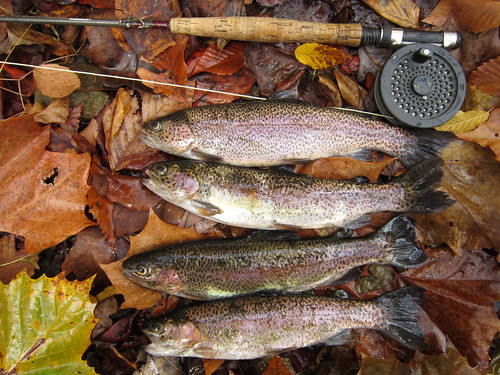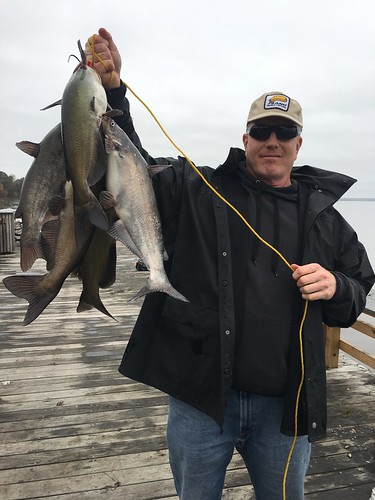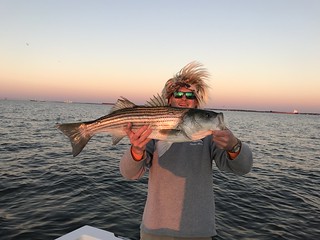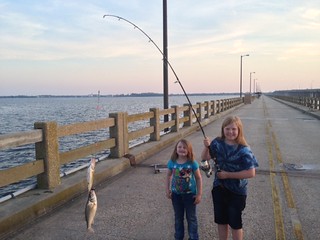Weekly Fishing Report: November 8
 The fall colors are in full swing throughout much of Maryland this week, offering some added delight to fishing experiences; the leaves won’t last much longer so don’t miss out.
The fall colors are in full swing throughout much of Maryland this week, offering some added delight to fishing experiences; the leaves won’t last much longer so don’t miss out.
Meanwhile, many of the best fishing opportunities are occurring this month, as fish feel the need to feed and prepare for the winter.
Before we get into this week’s fishing report, I wanted to remind everyone that they can submit their own fishing reports and photos to the Maryland Angler’s Log. To post a report, please email your name, hometown, photos, location information and additional content for your report. All information is optional, but encouraged. New reports are posted daily during the busy fishing seasons.

John Horgan holds up a nice stringer of upper bay catfish caught on cut bait. Photo courtesy of John Horgan
The upper bay region continues to offer some of the best opportunities for finding striped bass over 20 inches in length. As most anglers know, these rockfish have been there most of the summer, and since there is plenty of bait in the region the larger fish don’t have much reason to go anywhere else. There are a lot of small striped bass in the 12 to 18-inch size range chasing bay anchovies. The larger fish can be found underneath the surface action of the smaller fish; they can also be found suspended along channel edges in the bay and at the mouths of several of the larger tidal rivers. The lower Patapsco, Magothy and Chester rivers have been providing larger fish along channel edges at Love Point, Craighill Channel and Podickory Point. The Bay Bridge piers and rock piles in 25 feet to 60 feet of water have also been providing good jigging. Soft plastic jigs in pearl tend to be a favorite.
Due to heavy rains in the upper Susquehanna watershed, the Conowingo Dam had to release some rather large amounts of water from Oct. 31 to Nov. 3, without any letup. The release caused a lot of silt to be scoured out from behind the dam, which created turbid water conditions below the dam. Water releases are more moderate now and conditions are improving, as is the fishing. A large number of juvenile gizzard shad and perhaps American shad passed through the gates, creating a bounty of bait for striped bass in the area, which in turn improves fishing success. Water temperatures at the mouth of the Susquehanna River are about 53 degrees.
Trolling along channel edges in the upper bay region has been a good way to target larger striped bass this week. Umbrella rigs behind inline weights have been a good choice and red surge tubes lures, swim shads and bucktails have been working well also. Slow trolling bucktails and swim shads along channel edges in the lower sections of the tidal rivers has proved to be a very good option lately.
There continues to be good fishing for a mix of white perch and channel catfish in the tidal rivers and selected shoal areas in the bay. As water temperatures drop, expect white perch to move toward deeper areas in the lower sections of the tidal rivers. Most anglers will find the best success with bottom rigs baited with pieces of bloodworms. This time of year also finds excellent opportunities for catching channel catfish in the tidal rivers. Cooler water temperatures have spurred the catfish into increased activity. Cut bait from menhaden or gizzard shad, chicken livers and nightcrawlers are all good choices for bait.

Kevin Thomas went out Halloween evening in partial costume and received a treat with this nice fish while jigging near Tolly’s Bar. Photo by Rob Turnblacer
In the middle bay region, water temperatures are about 63 degrees and the tidal rivers are running up to 10 degrees cooler. Bait is moving out of the tidal rivers now in greater numbers and juvenile menhaden and silversides are adding to the schools of bay anchovies, which are being chased by small striped bass throughout the region. Diving sea gulls and breaking fish can be encountered at any time but late afternoons have been providing the most action. The small striped bass can provide some fun catch-and-release action on light tackle and most will agree that you have to keep moving with the fish.
Jigging deep underneath the surface action offers the best opportunity to tie into larger striped bass that are lingering deep and the larger fish can also be found suspended along channel edges. My personal experiences on the lower Choptank River reveal sparse chances of finding larger striped bass, but friends fishing in the lower Miles River and Eastern Bay areas have been finding better numbers of larger fish. Lately, the western side of the bay channel edges from Thomas Point up to Hackett’s Bar have also been providing good jigging action on larger striped bass.
There has been some good shallow water action for striped bass in the middle bay region recently for those casting topwater lures in the evening hours. There are plenty of locations to try some topwater fishing along bay shorelines and in the lower sections of the region’s tidal rivers, Eastern Bay, Poplar Island area, Thomas Point and countless points and shoreline structure areas. Small sub-legal striped bass can be pesky at times but the rewards of fish above 25 inches definitely make it worthwhile to spend some time throwing your favorite topwater lure.
Trolling can be a good option and there are two basic types of trolling that are catching fish this week. The first is the typical trolling of umbrella rigs and a mix of bucktails, red surge tube lures and swim shads down deep along major channel edges in the bay. The second is to slow troll bucktails dressed with twistertails or diving crankbait type lures in the lower sections of the tidal rivers along shorelines in about 15 feet of water. Most are using relatively light tackle; a small conventional or spinning outfit loaded with braid set out as flat lines works just fine. It is also a productive way to put nice fish in the boat while peacefully motoring around in relatively protected waters.
As mentioned earlier, white perch are steadily moving into deeper areas in the lower sections of the tidal rivers and can offer some fun fishing and tasty eating. Bloodworms are one of the easier baits to obtain and do fine on a two hook bottom rig. Most of the tidal rivers also have good populations of channel catfish in the middle to upper regions of the rivers.
If larger fish are on your mind, fishing for striped bass in the lower bay region this week has centered around the lower Potomac and Patuxent rivers. Those trolling or jigging along the steep channel edge from St. Georges Island south to Point Lookout have been succeeding with a nice grade of fish. Trolling with a mix of umbrella rigs, swim shads, bucktails, parachutes and red surge tubes close to the bottom has been working well. In the lower Patuxent the fish tend to be higher in the water column.
Breaking fish can be found most anywhere in the region and are usually fast moving and under the 20-inch mark. Seasoned fishermen know that it is often worth the effort to try jigging deep underneath the surface fish for larger striped bass that tend to linger deep. White or pearl-colored soft plastic jigs have been a favorite lure selection.
Casting topwater lures or swim shads in the evening hours for striped bass on the western shore has been good near shoreline structure areas, like points. On the eastern side of the bay the marsh edges are being targeted for a mix of smaller striped bass and some impressive speckled trout. The cuts through Hooper’s Island have also been a great place to cast jigs and swim shads for a mix of striped bass and speckled trout.
The Patuxent, Nanticoke and Wicomico rivers have been very popular with those fishing for white perch holding in deeper areas where there is good hard bottom while areas such as Cornfield Harbor and St. Mary’s River should not be overlooked. Bloodworms on a two hook bottom rig tends to be the favored way to fish.
Weekly Fishing Conditions Forecast Summary – Nov. 8-14
The department’s recent bay monitoring data is showing how those pre-Halloween fronts moving through have had a big impact on bay conditions. The prolonged winds and cool temperatures have resulted in a well-mixed water column with suitable oxygen conditions and uniform water temperatures from surface to bottom. This will require anglers to expand their search area to include areas typically deeper than they normally fish.
More upcoming unstable weather patterns from windy, cool weather will continue to drive down water temperatures resulting in bay gamefish continuing their movement out of the rivers and into and down the bay. Main bay water temperatures have cooled down to mostly the upper 50s with the coolest waters found in the upper bay and upper tidal Potomac River near the Woodrow Wilson Bridge. The warmer waters are found from the Gooses Reef south to the mouth of the Potomac River.
Expect some reduced water clarity as a result of recent rains and prolonged winds. Except for the Susquehanna, expect increased flows for streams and rivers entering Maryland’s portion of the bay (western side) as a result of recent rains (about an inch) and potential rains Monday. There will be excellent tidal currents conditions today and Monday through Wednesday as a result of the new moon Nov. 18. Windy conditions today through Saturday could impact timing and magnitude of tidal currents.
For the full weekly fishing conditions summary and more detailed and up-to-date fishing conditions in your area of the bay, be sure to check out Eyes on the Bay’s Click Before You Cast. Since this is a new feature for Chesapeake Bay anglers, drop us a line with comments or suggestions.

Steve Peperak holds up a beautiful walleye from a recent trip on the upper Potomac River. Photo by John Mullican
Cold nights and even snow melt runoff have driven water temperatures in the western region of the state to very comfortable levels for what are considered coldwater species such as trout, northern pike, walleye, yellow perch, smallmouth bass and chain pickerel. Fishing for trout continues to be good in most of the western region’s trout management waters. There are still some holdover trout in the put-and-take areas, and the catch-and-release areas offer fun fishing experiences.
At Deep Creek Lake, the focus is on walleye, smallmouth bass and yellow perch along steep rocky shorelines and deep grass. When casting, small crankbaits and jigs are a good choice for smallmouth bass, small jigs and live minnows for yellow perch and small jerkbaits and minnows for walleye.
The upper Potomac River is flowing well due to recent rain and much of the loose grass has been cleaned out. Colder water temperatures mean good fishing for smallmouth bass and walleye. It is hard to beat tubes and swim shad type jigs for both.

Tommy Robinson holds up a whopper largemouth bass he caught recently in an Eastern Shore pond. Photo courtesy of Tommy Robinson
The many lakes, reservoirs and ponds that dot the landscape are providing some of the best fishing to be found as cooler water temperatures spur many fish into a burst of activity. Largemouth bass are holding in slightly deeper waters near any kind of hard cover, waiting to intercept crayfish and baitfish fleeing the shallows and headed for deep cover. Small crankbaits, jigs and craws are good choices to mimic crayfish moving along the bottom looking for a new home for the winter. Spinnerbaits and jerkbaits can be good choices to represent baitfish.
Fall is a wonderful time to fish for crappie as they school up near deep cover. Bridge piers, sunken treetops and marina piers are good places to look for them. Small jigs, tubes or minnows under a bobber are a good bet. The bridge piers and marina docks in many tidal areas such as the Potomac below the Wilson Bridge are a good example of tidal water opportunities. Liberty Reservoir has a fishing pier that parallels the Nicodemus Road Bridge, and Loch Raven Reservoir has a similar type fishing pier alongside Dulaney Valley Road Bridge – both offer excellent locations to fish for crappie. The department’s website has detailed information about many fishing hotspots in Maryland listed by county.
Fishing for blue catfish in the tidal Potomac River is in high gear this month and offers a great opportunity to catch a mess of good-eating fish with no creel limit or minimum size restrictions. The medium sized ones freeze up well and can provide some nice fish dinners through the winter months. A simple one hook bottom rig with fresh cut bait will get you into the action. Anchoring up alongside a channel edge will usually put you onto fish and there are shoreline fishing options at Fort Washington Park and Piscataway Park areas as well.
As cold weather begins to descend on the Ocean City area, there are dramatic changes occurring in the local fishing scene. Surf casters who are fishing small baits are catching a mix of kingfish, sea trout and flounder. Anglers fishing with finger mullet rigs are catching small bluefish. Sub-legal striped bass are becoming more common in the surf and based on reports from Long Island and New Jersey beaches it will be a while before the larger striped bass begin to show up along Maryland beaches.
At the inlet, flounder are still being targeted as they pass through the inlet headed for offshore waters. Many are small but those using larger baits are catching some doormat-sized fish. Live bait such as mullet or small menhaden make excellent baits as do soft plastic baits. Sheepshead are still being caught at the jetties on sand fleas and pieces of green crab, as is tautog. Most of the tautog tend to be under the 16-inch minimum. In the evenings striped bass are being caught on bucktails and swim shads, but most all fall under the 28-inch minimum length.
In the back bay channels flounder are being caught along with a few sea trout. Striped bass are providing plenty of fun catch and release action from the inlet to the Route 90 Bridge area. Swim shads and paddletails tend to be the favorite lures to use when casting toward marsh edges.
Outside the inlet the boats headed to the wreck and reef sites are finding good quantities of sea bass holding to deep structure. Clams tend to be the most popular bait and limit catches are very common. Tautog are also part of the mix for those who bait up and fish for them. The same holds for flounder; there continues to be a good number of large flounder holding near the wreck sites. Bluefish have been showing up now and then at the sea bass fishing sites also. When the weather permits there is deep drop fishing for tilefish out near the canyons and chicken dolphin are still being found near lobster buoys.
“The surf: certainly one of nature’s finest edges.” -Russell Chatham
 ABOUT THE AUTHOR Keith Lockwood has been writing the Fishing Report since 2003 and has had a long career as a fisheries research biologist since 1973. Over the course of his career he has studied estuarine fishery populations, ocean species, and over a decade long study of bioaccumulation of chemicals in aquatic species in New Jersey. Upon moving to Oxford on the eastern shore of Maryland; research endeavors focused on a variety of catch and release studies as well as other fisheries related research at the Cooperative Oxford Laboratory. Education and outreach to the fishing public has always been an important component to the mission of these studies. Keith is an avid outdoorsman enjoying hunting, fishing, bird dogs, family and life on the eastern shore of Maryland.
ABOUT THE AUTHOR Keith Lockwood has been writing the Fishing Report since 2003 and has had a long career as a fisheries research biologist since 1973. Over the course of his career he has studied estuarine fishery populations, ocean species, and over a decade long study of bioaccumulation of chemicals in aquatic species in New Jersey. Upon moving to Oxford on the eastern shore of Maryland; research endeavors focused on a variety of catch and release studies as well as other fisheries related research at the Cooperative Oxford Laboratory. Education and outreach to the fishing public has always been an important component to the mission of these studies. Keith is an avid outdoorsman enjoying hunting, fishing, bird dogs, family and life on the eastern shore of Maryland.
Want the Weekly Fishing Report sent right to your inbox? Click here to sign up!



 1-888-373-7888
1-888-373-7888 233733
233733